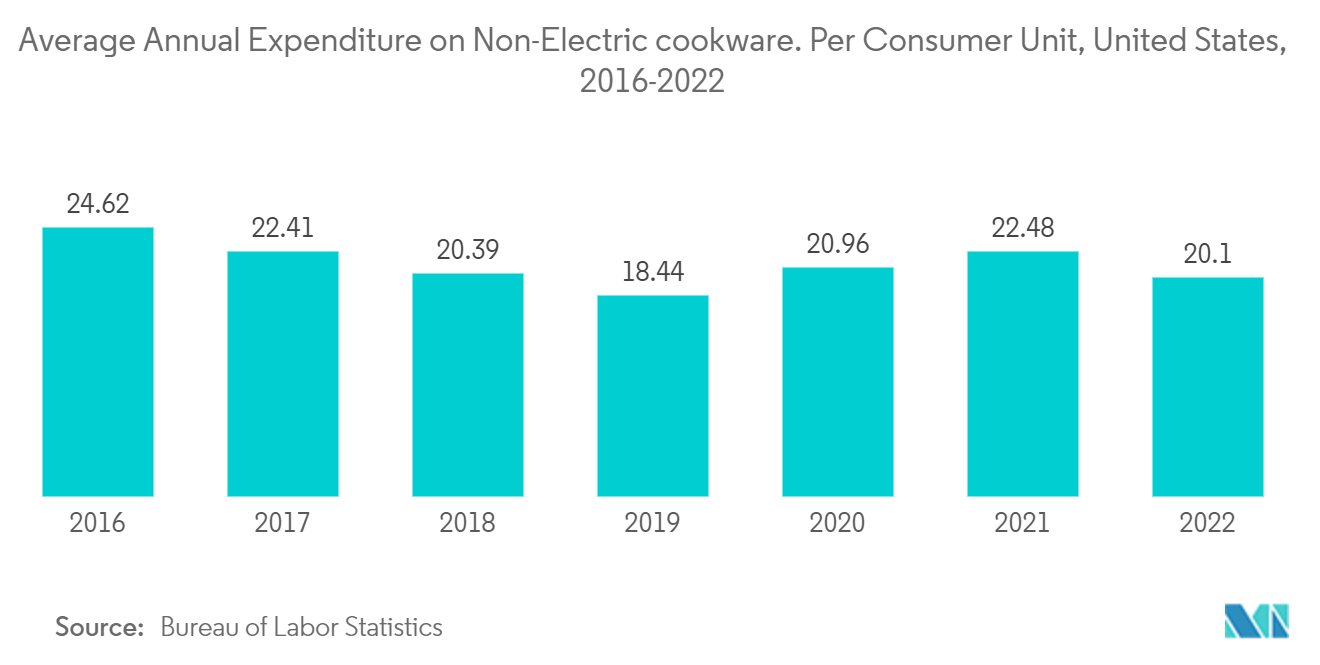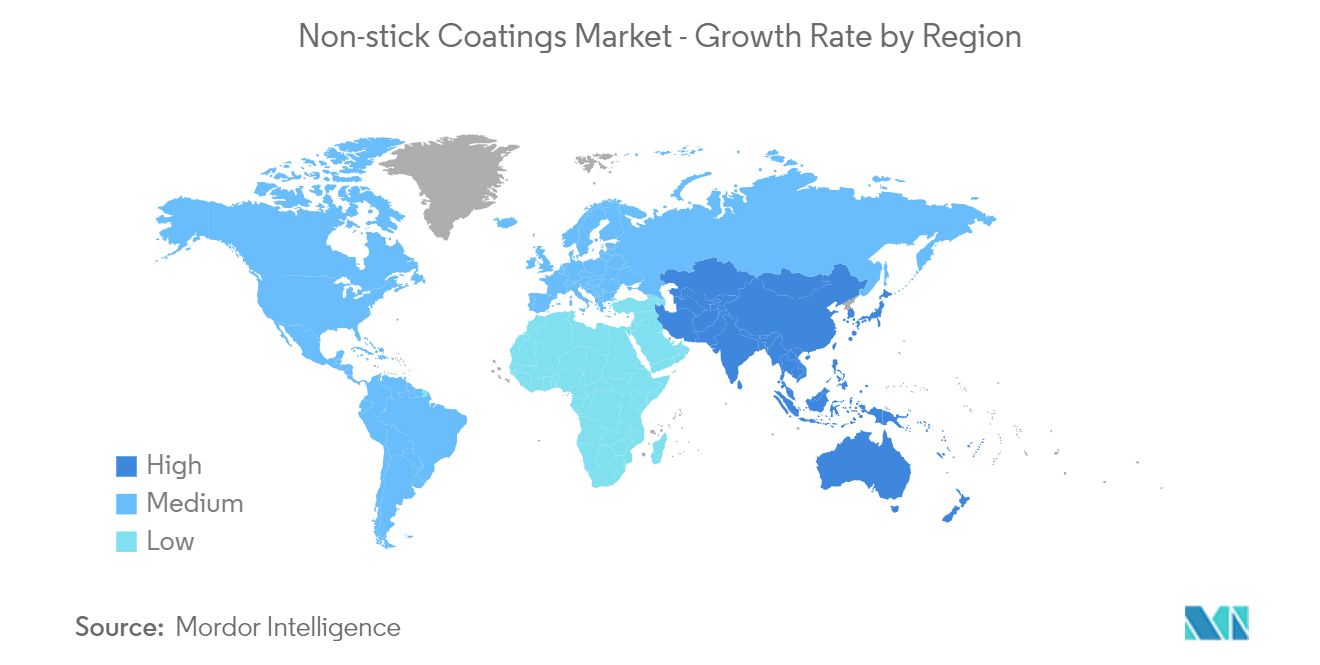Market Trends of Non-stick Coatings Industry
Cookware Application to Dominate the Market
- Non-stick coatings have been used on cookware for more than five decades. Most cookware is made of stainless steel, aluminum, cast iron, glass, program, and ceramic, while some bakeware is made from flexible silicone. The superior properties of non-stick coatings make them popular for various food-grade non-stick applications, including cookware, such as pots and pans.
- Non-stick cookware, such as frying pans and saucepans, is coated with polytetrafluoroethylene (PTFE), sometimes called Teflon. Due to its non-stick surface, Teflon-coated cookware is easy to use and clean. It also uses less oil or butter, making it a low-fat way of cooking and frying meals.
- Over the years, non-stick cookware has received negative attention regarding its safety and health issues due to the emission of toxic chemicals. However, Food and Drug Administration scientists have confirmed that the coatings are safe for human use. Cookware without perfluorooctanoic acid (PFOA) is considered more environmentally friendly than those made with other non-stick coatings.
- Hence, traditional PTFE pans are at the low end of the cookware market, whereas non-PFOA coatings, ceramics, and silicone-based coatings are at the high end, used as an alternative to Teflon-free products.
- According to the Bureau of Labor Statistics, the average annual expenditure on non-electric cookware in the United States is valued at USD 20.1 per consumer unit.
- Similarly, according to the Federal Statistical Office, a federal authority of Germany, the revenues of the kitchen industry in Germany valued at EUR 6.28 billion (USD 6.74 billion) in 2022 and registered growth when compared to EUR 5.81 billion (USD 6.23 billion) in 2021.
- Furthermore, the growth of the food industry positively influences the cookware market by fostering increased home cooking activities, encouraging innovation in cookware design, and stimulating demand for specialized products aligned with diverse culinary trends and consumer preferences.
- For instance, the sales revenue of the food service industry in Brazil reached BRL 208 billion (USD 41.85 billion) in 2022 and registered growth when compared to BRL 176.2 billion (USD 35.45 billion) in 2021.
- All the factors above are expected to augment the demand for non-stick coatings for cookware applications during the forecast period.

Asia-Pacific Region to Dominate the Market
- The Asia-Pacific region dominates the global non-stick coatings market owing to the increasing average household income and improving quality of life in the region. The population of the countries in Asia is increasing, resulting in an increased number of houses. This, in turn, increases the demand for household appliances, including kitchen appliances and cookware.
- China and India are the largest consumers of non-stick coatings in the Asia-Pacific region. China and India's demands for cookware have grown, especially since most local consumers are undergoing a complete transition of adopting cookware with better quality. As a result, a more comprehensive range of colorful, advanced cookware functions, such as pressure cookers of various materials, non-stick cookers, electric hot pots, induction cookers, and other cookware products, are being used more frequently.
- China's textile and carpet industries are two of the country's most important industries. According to China's National Bureau of Statistics, the country's carpet export volume has increased significantly in recent years. According to the United Nations COMTRADE database on international trade, China's exports of carpets and other textile floor coverings totaled USD 3.85 billion in 2022.
- China is the world's largest producer of electronics. Electronic products, such as smartphones, televisions, and other personal devices, grew the fastest in the electronics segment. For instance, according to the National Bureau of Statistics of China, the retail trade revenue of household appliances and consumer electronics was valued at CNY 77.25 billion (USD 10.85 billion) in December 2023.
- According to the Ministry of Economy, Trade, and Industry in Japan, the electronics industry's total production value in 2022 amounted to JPY 10.98 trillion (USD 80 trillion), registering a marginal increase of 0.27% compared to the JPY 10.95 trillion recorded in 2021. This sector includes consumer electronic equipment, industrial electronic equipment, and electronic components and devices, directly impacting the industrial films market positively.
- The Japanese food processing industry is among the most advanced and sophisticated globally. According to the Statistics Bureau of Japan, the sales value of food and beverage retail trade in Japan reached JPY trillion 45.52 (USD 0.30 trillion) in 2022 and has been maintaining a similar range for the past few years.
- Similarly, according to OICA (the International Organization of Motor Vehicle Manufacturers), the motor vehicle sales volume in India reached 4.73 million units in 2022 and registered growth when compared to 3.76 million units in the previous year.
- Furthermore, according to the Korea Automobile Manufacturers Association, the number of vehicles manufactured in South Korea reached 3.76 million units, registering growth from previous years' data.
- All factors mentioned above are likely to fuel the growth of the Asia-Pacific non-stick coatings market over the forecast period.


